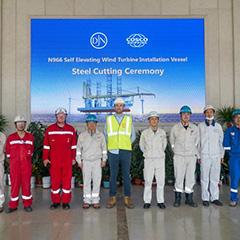Jan De Nul kicks off the construction of its next generation Offshore Jack-Up Installation Vessel Voltaire. The steel cutting ceremony took place on Monday at the Cosco Shipping Shipyard (Nantong) CO. Ltd in China, in the presence of Jan De Nul representatives, the shipyard and BV Classification Society.
The Voltaire is specifically designed to transport, lift and install offshore wind turbines, transition pieces and foundations for current and future developments. The vessel will have better operational limits compared to the existing Jack-Up installation vessels. Not only will this vessel be ready for the future of offshore renewables, it will also be deployable for the oil and gas industry, and for decommissioning of offshore structures. All these activities will be performed in a sustainable way thanks to lower fuel consumptions and emissions through Jan De Nul’s in house developed ULEv technique (Ultra Low Emission vessel).
Voltaire’s key features
The Voltaire is equipped with a main crane of over 3,000 tonnes and a DP2 system. The vessel has an operating depth of over 80 meters, a payload of about 14,000 tonnes and accommodation for 110 persons. With her four legs, the Voltaire can lift itself above the sea level for stable working conditions.
First seaworthy installation vessel in the world with extremely low emissions
When designing the vessel, Jan De Nul Group took into account the environmental impact. Jan De Nul tackles environmental challenges by focusing on reducing the footprint of its activities, particularly on water and air quality, and on the climate. Air pollution is one of the greatest threats to public health. Construction activities at sea are usually located close to coastlines, large and small ports, and densely populated areas. The Group is aware that, regardless of the choice of fuel or engine technology, the exhaust gases must always be filtered.
As one of the world’s leading players in hydraulic engineering, Jan De Nul Group pioneers in the field of such an emission treatment. The latest generation of Jan De Nul’s vessels is equipped with an exhaust gas filtering technology that complies with the strict European EURO STAGE V guidelines for emissions on land and inland waterways. Ultra-Low Emission vessels (ULEv), they are called. And so it is the case for the Voltaire.
The highly advanced dual exhaust filter system removes up to 99% of nanoparticles from emissions using a diesel particulate filter (DPF) followed by selective catalytic reduction system (SCR) for NOx removal.
As a result of these exhaust filtering systems, the Voltaire will be the first seaworthy installation vessel in the world with extremely low emissions.
About Jan De Nul Group
Design. Build. Connect. Jan De Nul Group shapes water and land. Worldwide. From complex services to the offshore energy and energy transition sector, over large dredging and defence works on the edge of water and land, to challenging civil and environmental works. Well integrated competences and investments lead to creative, sustainable and innovative solutions. In this way Jan De Nul Group delivers results that produce satisfied customers. Today, but also tomorrow. – www.jandenul.com


























